A Comprehensive Analysis of Climate Change Laws on Loss and Damage
VerifiedAdded on 2022/10/10
|32
|8615
|461
Report
AI Summary
This report provides a detailed analysis of climate change laws, specifically focusing on the concept of "loss and damage" resulting from climate change impacts. It begins by defining loss and damage and tracing its historical development within the context of the United Nations Framework Convention on Climate Change (UNFCCC) and the Paris Agreement, including the Warsaw International Mechanism. The report examines the scope, application, and legal implications of the loss and damage provision, including its limitations regarding liability and financial compensation. It further explores potential avenues for the evolution of the legal regime, such as updating international legal instruments and the role of litigation by states, individuals, and civil society. The report also addresses the challenges in international climate change litigation and negotiation processes, including the application of the no-harm principle and other relevant norms under international law. Finally, the report considers the alternatives available to developing countries in addressing loss and damage and provides a conclusion that summarizes the key findings and suggests potential future directions for legal and ethical frameworks to address climate change impacts.
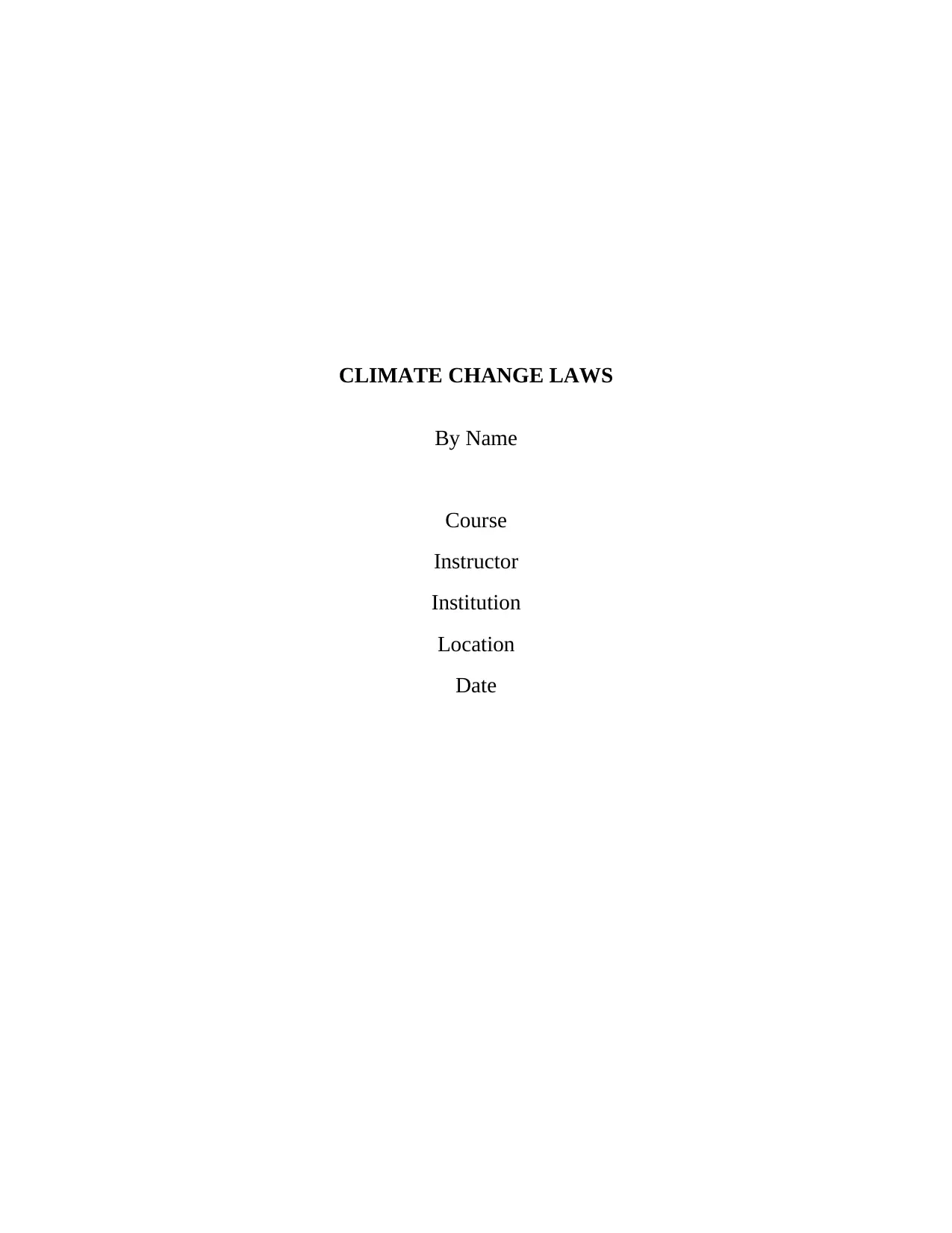
CLIMATE CHANGE LAWS
By Name
Course
Instructor
Institution
Location
Date
By Name
Course
Instructor
Institution
Location
Date
Paraphrase This Document
Need a fresh take? Get an instant paraphrase of this document with our AI Paraphraser
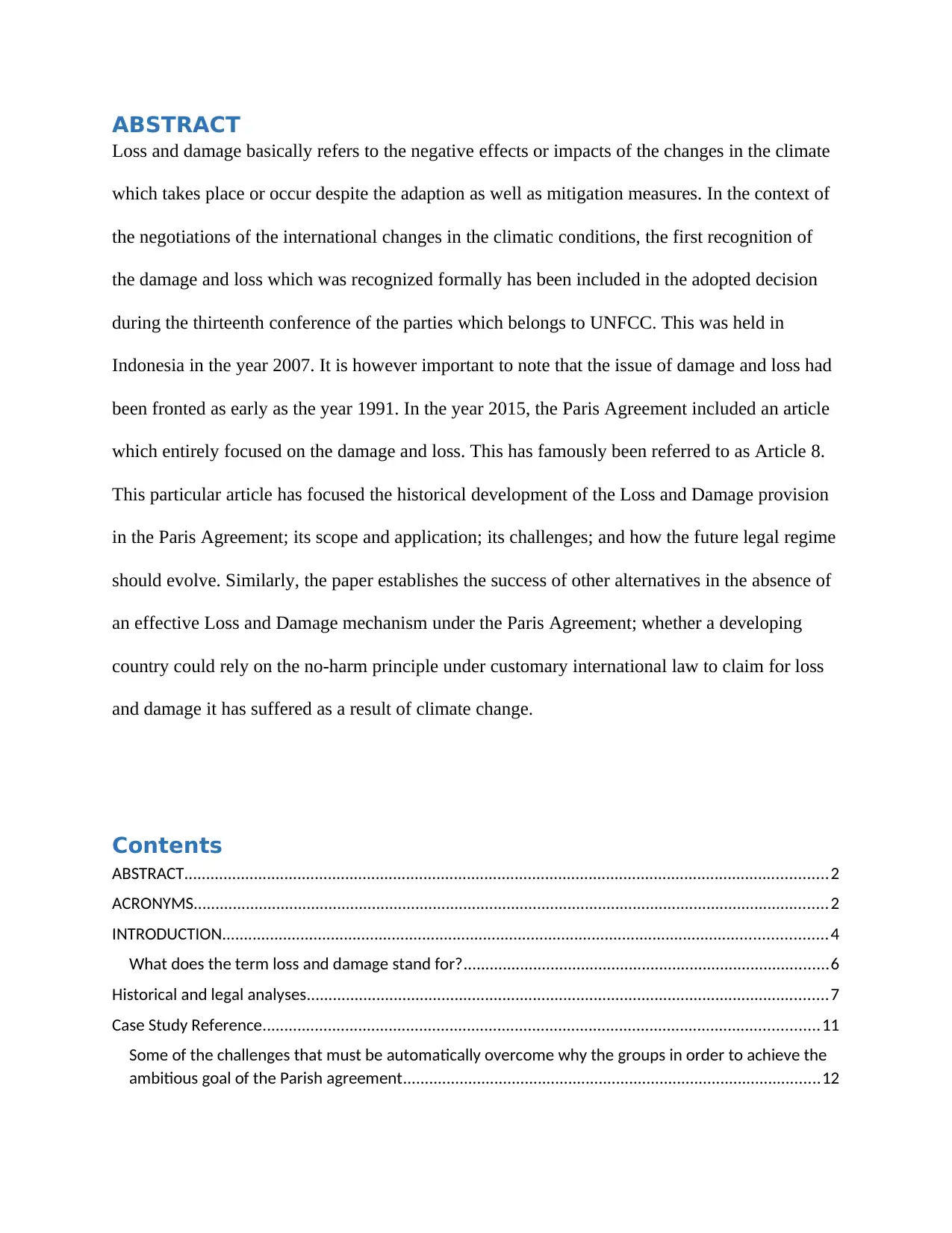
ABSTRACT
Loss and damage basically refers to the negative effects or impacts of the changes in the climate
which takes place or occur despite the adaption as well as mitigation measures. In the context of
the negotiations of the international changes in the climatic conditions, the first recognition of
the damage and loss which was recognized formally has been included in the adopted decision
during the thirteenth conference of the parties which belongs to UNFCC. This was held in
Indonesia in the year 2007. It is however important to note that the issue of damage and loss had
been fronted as early as the year 1991. In the year 2015, the Paris Agreement included an article
which entirely focused on the damage and loss. This has famously been referred to as Article 8.
This particular article has focused the historical development of the Loss and Damage provision
in the Paris Agreement; its scope and application; its challenges; and how the future legal regime
should evolve. Similarly, the paper establishes the success of other alternatives in the absence of
an effective Loss and Damage mechanism under the Paris Agreement; whether a developing
country could rely on the no-harm principle under customary international law to claim for loss
and damage it has suffered as a result of climate change.
Contents
ABSTRACT....................................................................................................................................................2
ACRONYMS..................................................................................................................................................2
INTRODUCTION...........................................................................................................................................4
What does the term loss and damage stand for?....................................................................................6
Historical and legal analyses........................................................................................................................7
Case Study Reference................................................................................................................................11
Some of the challenges that must be automatically overcome why the groups in order to achieve the
ambitious goal of the Parish agreement................................................................................................12
Loss and damage basically refers to the negative effects or impacts of the changes in the climate
which takes place or occur despite the adaption as well as mitigation measures. In the context of
the negotiations of the international changes in the climatic conditions, the first recognition of
the damage and loss which was recognized formally has been included in the adopted decision
during the thirteenth conference of the parties which belongs to UNFCC. This was held in
Indonesia in the year 2007. It is however important to note that the issue of damage and loss had
been fronted as early as the year 1991. In the year 2015, the Paris Agreement included an article
which entirely focused on the damage and loss. This has famously been referred to as Article 8.
This particular article has focused the historical development of the Loss and Damage provision
in the Paris Agreement; its scope and application; its challenges; and how the future legal regime
should evolve. Similarly, the paper establishes the success of other alternatives in the absence of
an effective Loss and Damage mechanism under the Paris Agreement; whether a developing
country could rely on the no-harm principle under customary international law to claim for loss
and damage it has suffered as a result of climate change.
Contents
ABSTRACT....................................................................................................................................................2
ACRONYMS..................................................................................................................................................2
INTRODUCTION...........................................................................................................................................4
What does the term loss and damage stand for?....................................................................................6
Historical and legal analyses........................................................................................................................7
Case Study Reference................................................................................................................................11
Some of the challenges that must be automatically overcome why the groups in order to achieve the
ambitious goal of the Parish agreement................................................................................................12
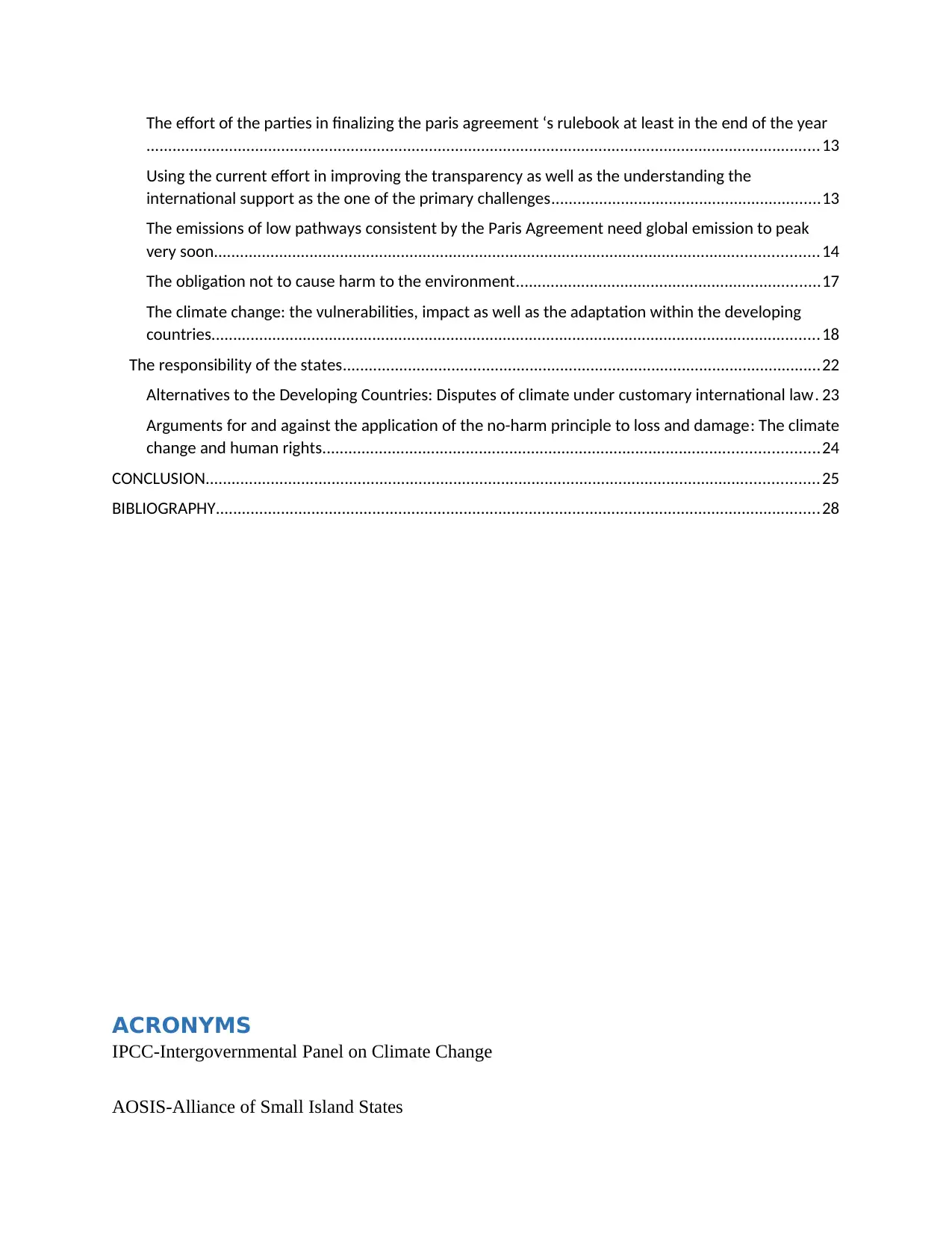
The effort of the parties in finalizing the paris agreement ‘s rulebook at least in the end of the year
...........................................................................................................................................................13
Using the current effort in improving the transparency as well as the understanding the
international support as the one of the primary challenges..............................................................13
The emissions of low pathways consistent by the Paris Agreement need global emission to peak
very soon...........................................................................................................................................14
The obligation not to cause harm to the environment......................................................................17
The climate change: the vulnerabilities, impact as well as the adaptation within the developing
countries............................................................................................................................................18
The responsibility of the states..............................................................................................................22
Alternatives to the Developing Countries: Disputes of climate under customary international law. 23
Arguments for and against the application of the no-harm principle to loss and damage: The climate
change and human rights..................................................................................................................24
CONCLUSION.............................................................................................................................................25
BIBLIOGRAPHY...........................................................................................................................................28
ACRONYMS
IPCC-Intergovernmental Panel on Climate Change
AOSIS-Alliance of Small Island States
...........................................................................................................................................................13
Using the current effort in improving the transparency as well as the understanding the
international support as the one of the primary challenges..............................................................13
The emissions of low pathways consistent by the Paris Agreement need global emission to peak
very soon...........................................................................................................................................14
The obligation not to cause harm to the environment......................................................................17
The climate change: the vulnerabilities, impact as well as the adaptation within the developing
countries............................................................................................................................................18
The responsibility of the states..............................................................................................................22
Alternatives to the Developing Countries: Disputes of climate under customary international law. 23
Arguments for and against the application of the no-harm principle to loss and damage: The climate
change and human rights..................................................................................................................24
CONCLUSION.............................................................................................................................................25
BIBLIOGRAPHY...........................................................................................................................................28
ACRONYMS
IPCC-Intergovernmental Panel on Climate Change
AOSIS-Alliance of Small Island States
⊘ This is a preview!⊘
Do you want full access?
Subscribe today to unlock all pages.

Trusted by 1+ million students worldwide
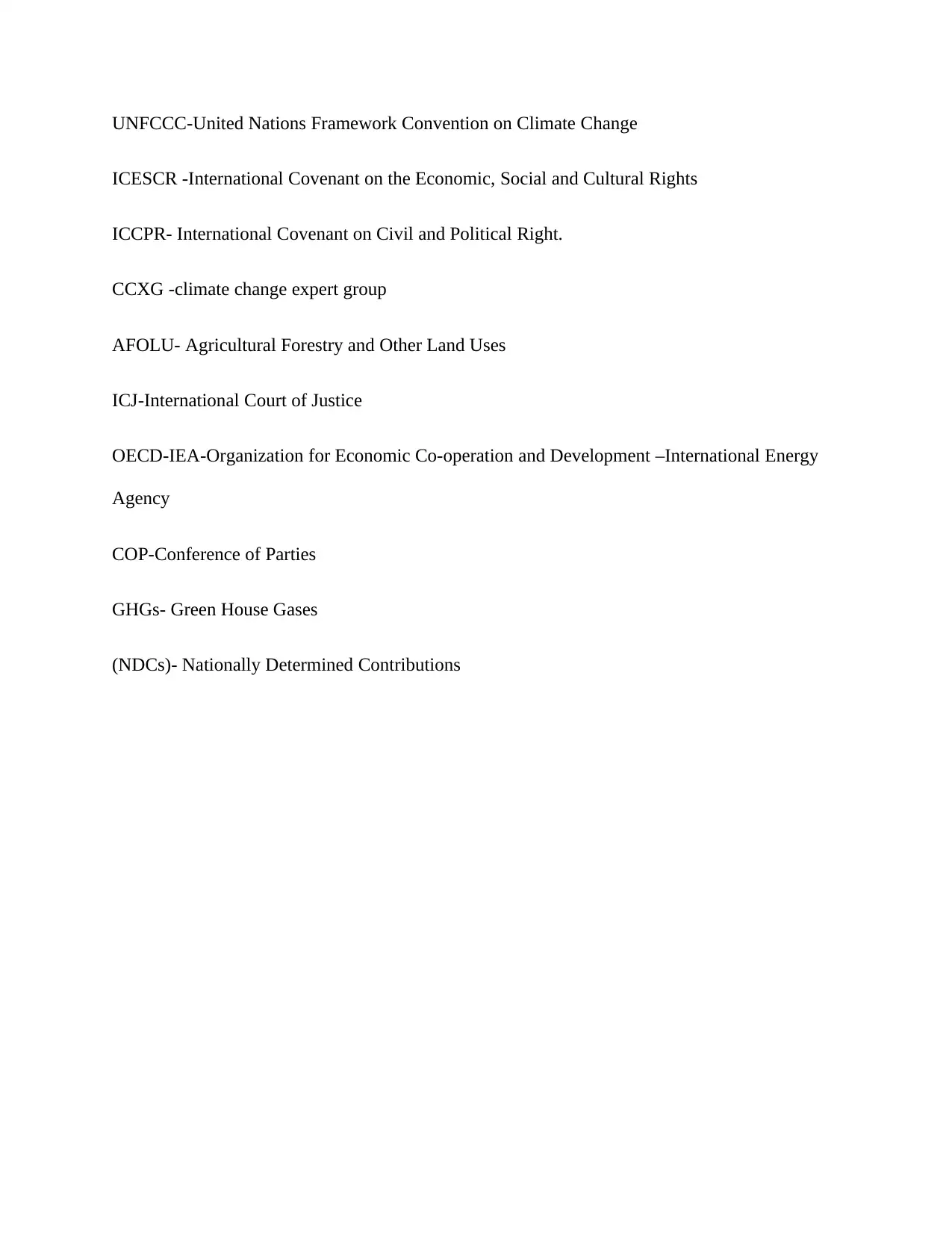
UNFCCC-United Nations Framework Convention on Climate Change
ICESCR -International Covenant on the Economic, Social and Cultural Rights
ICCPR- International Covenant on Civil and Political Right.
CCXG -climate change expert group
AFOLU- Agricultural Forestry and Other Land Uses
ICJ-International Court of Justice
OECD-IEA-Organization for Economic Co-operation and Development –International Energy
Agency
COP-Conference of Parties
GHGs- Green House Gases
(NDCs)- Nationally Determined Contributions
ICESCR -International Covenant on the Economic, Social and Cultural Rights
ICCPR- International Covenant on Civil and Political Right.
CCXG -climate change expert group
AFOLU- Agricultural Forestry and Other Land Uses
ICJ-International Court of Justice
OECD-IEA-Organization for Economic Co-operation and Development –International Energy
Agency
COP-Conference of Parties
GHGs- Green House Gases
(NDCs)- Nationally Determined Contributions
Paraphrase This Document
Need a fresh take? Get an instant paraphrase of this document with our AI Paraphraser
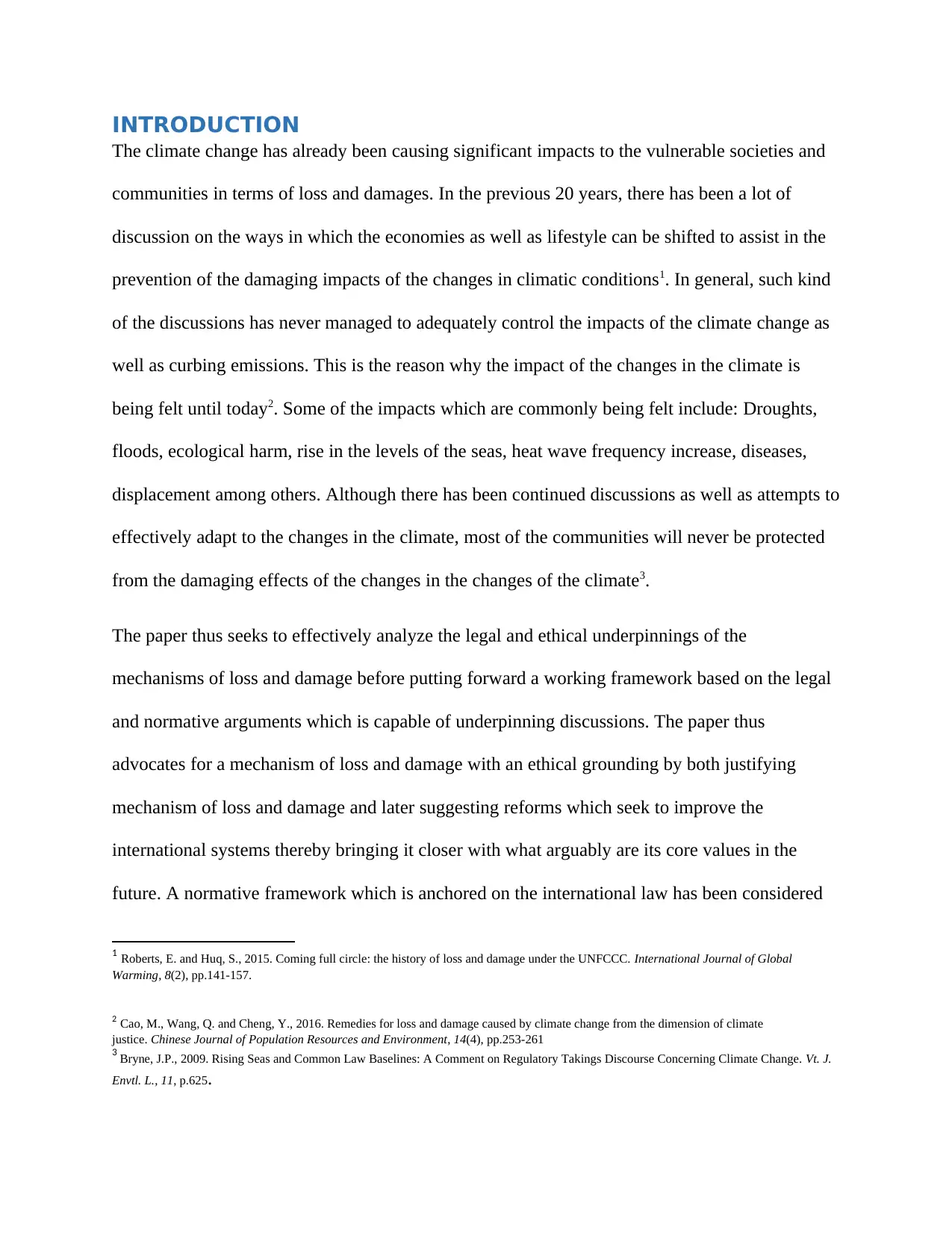
INTRODUCTION
The climate change has already been causing significant impacts to the vulnerable societies and
communities in terms of loss and damages. In the previous 20 years, there has been a lot of
discussion on the ways in which the economies as well as lifestyle can be shifted to assist in the
prevention of the damaging impacts of the changes in climatic conditions1. In general, such kind
of the discussions has never managed to adequately control the impacts of the climate change as
well as curbing emissions. This is the reason why the impact of the changes in the climate is
being felt until today2. Some of the impacts which are commonly being felt include: Droughts,
floods, ecological harm, rise in the levels of the seas, heat wave frequency increase, diseases,
displacement among others. Although there has been continued discussions as well as attempts to
effectively adapt to the changes in the climate, most of the communities will never be protected
from the damaging effects of the changes in the changes of the climate3.
The paper thus seeks to effectively analyze the legal and ethical underpinnings of the
mechanisms of loss and damage before putting forward a working framework based on the legal
and normative arguments which is capable of underpinning discussions. The paper thus
advocates for a mechanism of loss and damage with an ethical grounding by both justifying
mechanism of loss and damage and later suggesting reforms which seek to improve the
international systems thereby bringing it closer with what arguably are its core values in the
future. A normative framework which is anchored on the international law has been considered
1 Roberts, E. and Huq, S., 2015. Coming full circle: the history of loss and damage under the UNFCCC. International Journal of Global
Warming, 8(2), pp.141-157.
2 Cao, M., Wang, Q. and Cheng, Y., 2016. Remedies for loss and damage caused by climate change from the dimension of climate
justice. Chinese Journal of Population Resources and Environment, 14(4), pp.253-261
3 Bryne, J.P., 2009. Rising Seas and Common Law Baselines: A Comment on Regulatory Takings Discourse Concerning Climate Change. Vt. J.
Envtl. L., 11, p.625.
The climate change has already been causing significant impacts to the vulnerable societies and
communities in terms of loss and damages. In the previous 20 years, there has been a lot of
discussion on the ways in which the economies as well as lifestyle can be shifted to assist in the
prevention of the damaging impacts of the changes in climatic conditions1. In general, such kind
of the discussions has never managed to adequately control the impacts of the climate change as
well as curbing emissions. This is the reason why the impact of the changes in the climate is
being felt until today2. Some of the impacts which are commonly being felt include: Droughts,
floods, ecological harm, rise in the levels of the seas, heat wave frequency increase, diseases,
displacement among others. Although there has been continued discussions as well as attempts to
effectively adapt to the changes in the climate, most of the communities will never be protected
from the damaging effects of the changes in the changes of the climate3.
The paper thus seeks to effectively analyze the legal and ethical underpinnings of the
mechanisms of loss and damage before putting forward a working framework based on the legal
and normative arguments which is capable of underpinning discussions. The paper thus
advocates for a mechanism of loss and damage with an ethical grounding by both justifying
mechanism of loss and damage and later suggesting reforms which seek to improve the
international systems thereby bringing it closer with what arguably are its core values in the
future. A normative framework which is anchored on the international law has been considered
1 Roberts, E. and Huq, S., 2015. Coming full circle: the history of loss and damage under the UNFCCC. International Journal of Global
Warming, 8(2), pp.141-157.
2 Cao, M., Wang, Q. and Cheng, Y., 2016. Remedies for loss and damage caused by climate change from the dimension of climate
justice. Chinese Journal of Population Resources and Environment, 14(4), pp.253-261
3 Bryne, J.P., 2009. Rising Seas and Common Law Baselines: A Comment on Regulatory Takings Discourse Concerning Climate Change. Vt. J.
Envtl. L., 11, p.625.
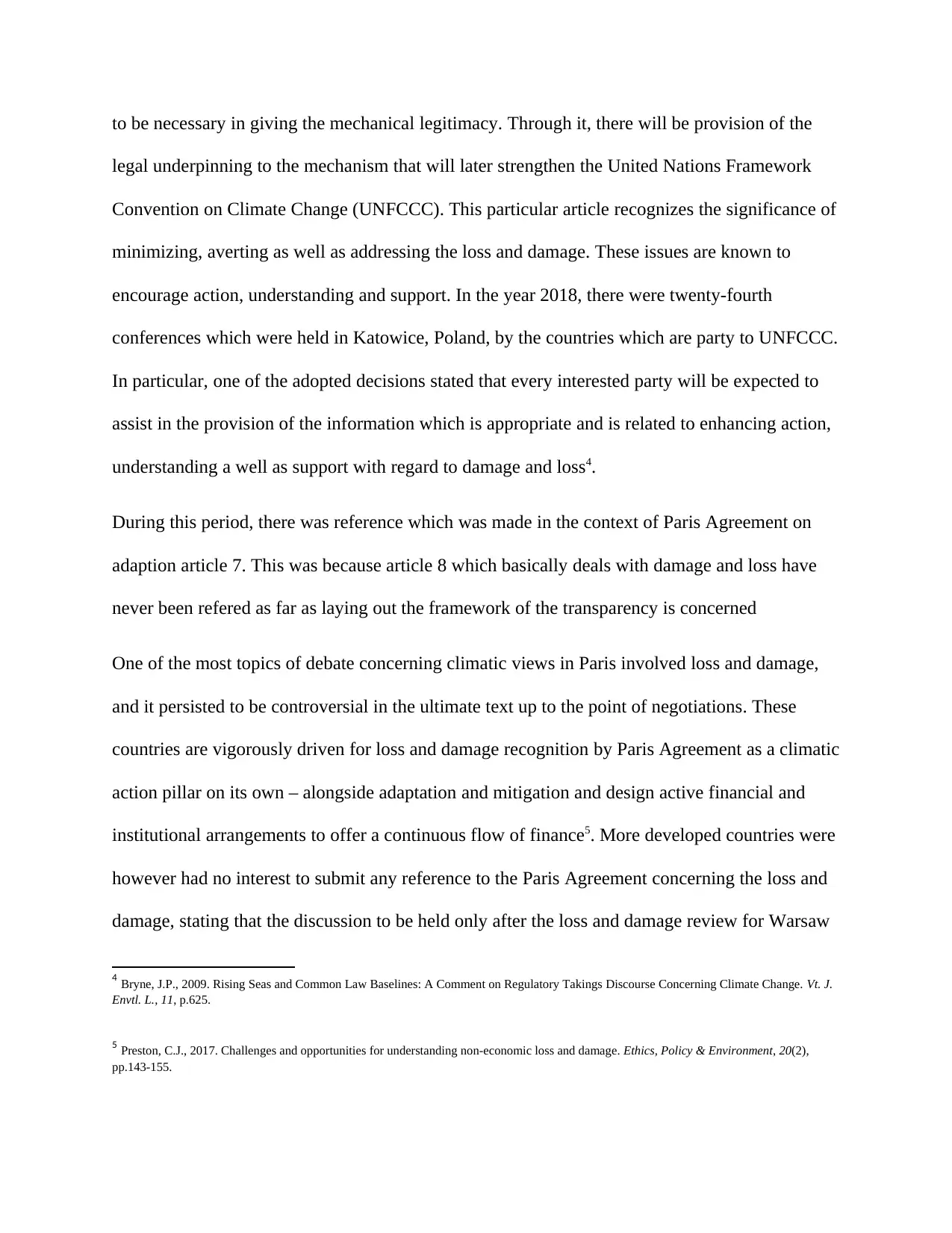
to be necessary in giving the mechanical legitimacy. Through it, there will be provision of the
legal underpinning to the mechanism that will later strengthen the United Nations Framework
Convention on Climate Change (UNFCCC). This particular article recognizes the significance of
minimizing, averting as well as addressing the loss and damage. These issues are known to
encourage action, understanding and support. In the year 2018, there were twenty-fourth
conferences which were held in Katowice, Poland, by the countries which are party to UNFCCC.
In particular, one of the adopted decisions stated that every interested party will be expected to
assist in the provision of the information which is appropriate and is related to enhancing action,
understanding a well as support with regard to damage and loss4.
During this period, there was reference which was made in the context of Paris Agreement on
adaption article 7. This was because article 8 which basically deals with damage and loss have
never been refered as far as laying out the framework of the transparency is concerned
One of the most topics of debate concerning climatic views in Paris involved loss and damage,
and it persisted to be controversial in the ultimate text up to the point of negotiations. These
countries are vigorously driven for loss and damage recognition by Paris Agreement as a climatic
action pillar on its own – alongside adaptation and mitigation and design active financial and
institutional arrangements to offer a continuous flow of finance5. More developed countries were
however had no interest to submit any reference to the Paris Agreement concerning the loss and
damage, stating that the discussion to be held only after the loss and damage review for Warsaw
4 Bryne, J.P., 2009. Rising Seas and Common Law Baselines: A Comment on Regulatory Takings Discourse Concerning Climate Change. Vt. J.
Envtl. L., 11, p.625.
5 Preston, C.J., 2017. Challenges and opportunities for understanding non-economic loss and damage. Ethics, Policy & Environment, 20(2),
pp.143-155.
legal underpinning to the mechanism that will later strengthen the United Nations Framework
Convention on Climate Change (UNFCCC). This particular article recognizes the significance of
minimizing, averting as well as addressing the loss and damage. These issues are known to
encourage action, understanding and support. In the year 2018, there were twenty-fourth
conferences which were held in Katowice, Poland, by the countries which are party to UNFCCC.
In particular, one of the adopted decisions stated that every interested party will be expected to
assist in the provision of the information which is appropriate and is related to enhancing action,
understanding a well as support with regard to damage and loss4.
During this period, there was reference which was made in the context of Paris Agreement on
adaption article 7. This was because article 8 which basically deals with damage and loss have
never been refered as far as laying out the framework of the transparency is concerned
One of the most topics of debate concerning climatic views in Paris involved loss and damage,
and it persisted to be controversial in the ultimate text up to the point of negotiations. These
countries are vigorously driven for loss and damage recognition by Paris Agreement as a climatic
action pillar on its own – alongside adaptation and mitigation and design active financial and
institutional arrangements to offer a continuous flow of finance5. More developed countries were
however had no interest to submit any reference to the Paris Agreement concerning the loss and
damage, stating that the discussion to be held only after the loss and damage review for Warsaw
4 Bryne, J.P., 2009. Rising Seas and Common Law Baselines: A Comment on Regulatory Takings Discourse Concerning Climate Change. Vt. J.
Envtl. L., 11, p.625.
5 Preston, C.J., 2017. Challenges and opportunities for understanding non-economic loss and damage. Ethics, Policy & Environment, 20(2),
pp.143-155.
⊘ This is a preview!⊘
Do you want full access?
Subscribe today to unlock all pages.

Trusted by 1+ million students worldwide
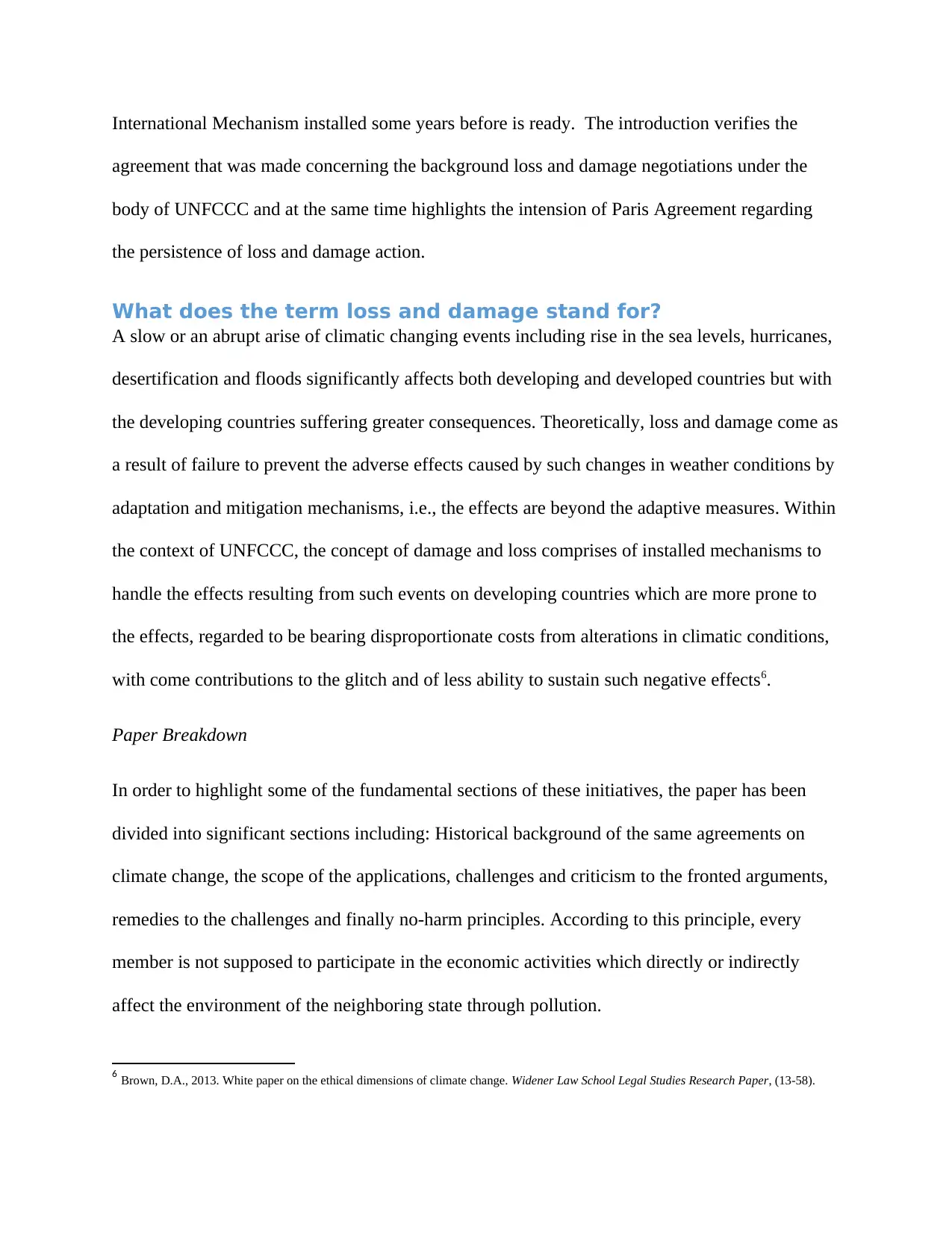
International Mechanism installed some years before is ready. The introduction verifies the
agreement that was made concerning the background loss and damage negotiations under the
body of UNFCCC and at the same time highlights the intension of Paris Agreement regarding
the persistence of loss and damage action.
What does the term loss and damage stand for?
A slow or an abrupt arise of climatic changing events including rise in the sea levels, hurricanes,
desertification and floods significantly affects both developing and developed countries but with
the developing countries suffering greater consequences. Theoretically, loss and damage come as
a result of failure to prevent the adverse effects caused by such changes in weather conditions by
adaptation and mitigation mechanisms, i.e., the effects are beyond the adaptive measures. Within
the context of UNFCCC, the concept of damage and loss comprises of installed mechanisms to
handle the effects resulting from such events on developing countries which are more prone to
the effects, regarded to be bearing disproportionate costs from alterations in climatic conditions,
with come contributions to the glitch and of less ability to sustain such negative effects6.
Paper Breakdown
In order to highlight some of the fundamental sections of these initiatives, the paper has been
divided into significant sections including: Historical background of the same agreements on
climate change, the scope of the applications, challenges and criticism to the fronted arguments,
remedies to the challenges and finally no-harm principles. According to this principle, every
member is not supposed to participate in the economic activities which directly or indirectly
affect the environment of the neighboring state through pollution.
6 Brown, D.A., 2013. White paper on the ethical dimensions of climate change. Widener Law School Legal Studies Research Paper, (13-58).
agreement that was made concerning the background loss and damage negotiations under the
body of UNFCCC and at the same time highlights the intension of Paris Agreement regarding
the persistence of loss and damage action.
What does the term loss and damage stand for?
A slow or an abrupt arise of climatic changing events including rise in the sea levels, hurricanes,
desertification and floods significantly affects both developing and developed countries but with
the developing countries suffering greater consequences. Theoretically, loss and damage come as
a result of failure to prevent the adverse effects caused by such changes in weather conditions by
adaptation and mitigation mechanisms, i.e., the effects are beyond the adaptive measures. Within
the context of UNFCCC, the concept of damage and loss comprises of installed mechanisms to
handle the effects resulting from such events on developing countries which are more prone to
the effects, regarded to be bearing disproportionate costs from alterations in climatic conditions,
with come contributions to the glitch and of less ability to sustain such negative effects6.
Paper Breakdown
In order to highlight some of the fundamental sections of these initiatives, the paper has been
divided into significant sections including: Historical background of the same agreements on
climate change, the scope of the applications, challenges and criticism to the fronted arguments,
remedies to the challenges and finally no-harm principles. According to this principle, every
member is not supposed to participate in the economic activities which directly or indirectly
affect the environment of the neighboring state through pollution.
6 Brown, D.A., 2013. White paper on the ethical dimensions of climate change. Widener Law School Legal Studies Research Paper, (13-58).
Paraphrase This Document
Need a fresh take? Get an instant paraphrase of this document with our AI Paraphraser
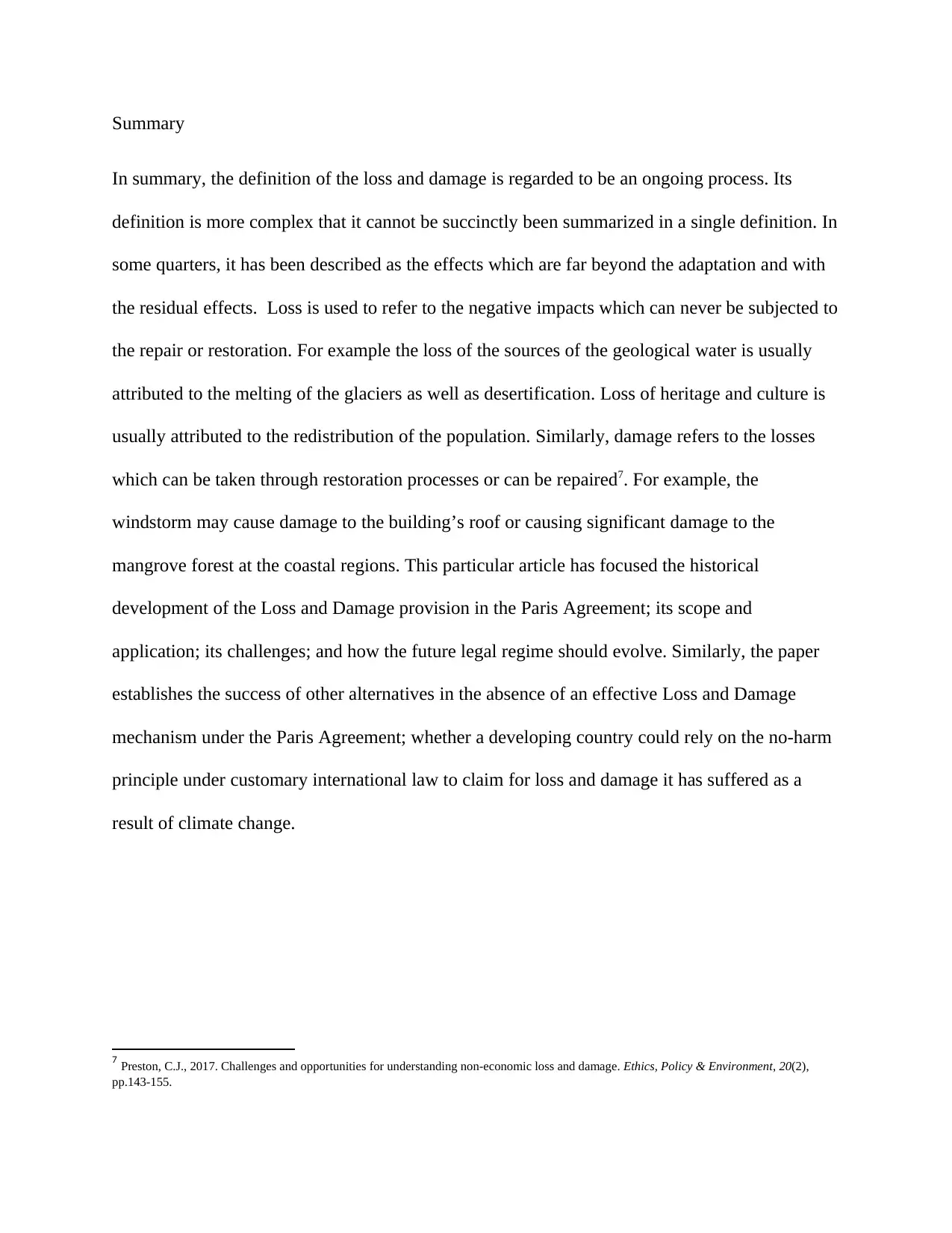
Summary
In summary, the definition of the loss and damage is regarded to be an ongoing process. Its
definition is more complex that it cannot be succinctly been summarized in a single definition. In
some quarters, it has been described as the effects which are far beyond the adaptation and with
the residual effects. Loss is used to refer to the negative impacts which can never be subjected to
the repair or restoration. For example the loss of the sources of the geological water is usually
attributed to the melting of the glaciers as well as desertification. Loss of heritage and culture is
usually attributed to the redistribution of the population. Similarly, damage refers to the losses
which can be taken through restoration processes or can be repaired7. For example, the
windstorm may cause damage to the building’s roof or causing significant damage to the
mangrove forest at the coastal regions. This particular article has focused the historical
development of the Loss and Damage provision in the Paris Agreement; its scope and
application; its challenges; and how the future legal regime should evolve. Similarly, the paper
establishes the success of other alternatives in the absence of an effective Loss and Damage
mechanism under the Paris Agreement; whether a developing country could rely on the no-harm
principle under customary international law to claim for loss and damage it has suffered as a
result of climate change.
7 Preston, C.J., 2017. Challenges and opportunities for understanding non-economic loss and damage. Ethics, Policy & Environment, 20(2),
pp.143-155.
In summary, the definition of the loss and damage is regarded to be an ongoing process. Its
definition is more complex that it cannot be succinctly been summarized in a single definition. In
some quarters, it has been described as the effects which are far beyond the adaptation and with
the residual effects. Loss is used to refer to the negative impacts which can never be subjected to
the repair or restoration. For example the loss of the sources of the geological water is usually
attributed to the melting of the glaciers as well as desertification. Loss of heritage and culture is
usually attributed to the redistribution of the population. Similarly, damage refers to the losses
which can be taken through restoration processes or can be repaired7. For example, the
windstorm may cause damage to the building’s roof or causing significant damage to the
mangrove forest at the coastal regions. This particular article has focused the historical
development of the Loss and Damage provision in the Paris Agreement; its scope and
application; its challenges; and how the future legal regime should evolve. Similarly, the paper
establishes the success of other alternatives in the absence of an effective Loss and Damage
mechanism under the Paris Agreement; whether a developing country could rely on the no-harm
principle under customary international law to claim for loss and damage it has suffered as a
result of climate change.
7 Preston, C.J., 2017. Challenges and opportunities for understanding non-economic loss and damage. Ethics, Policy & Environment, 20(2),
pp.143-155.
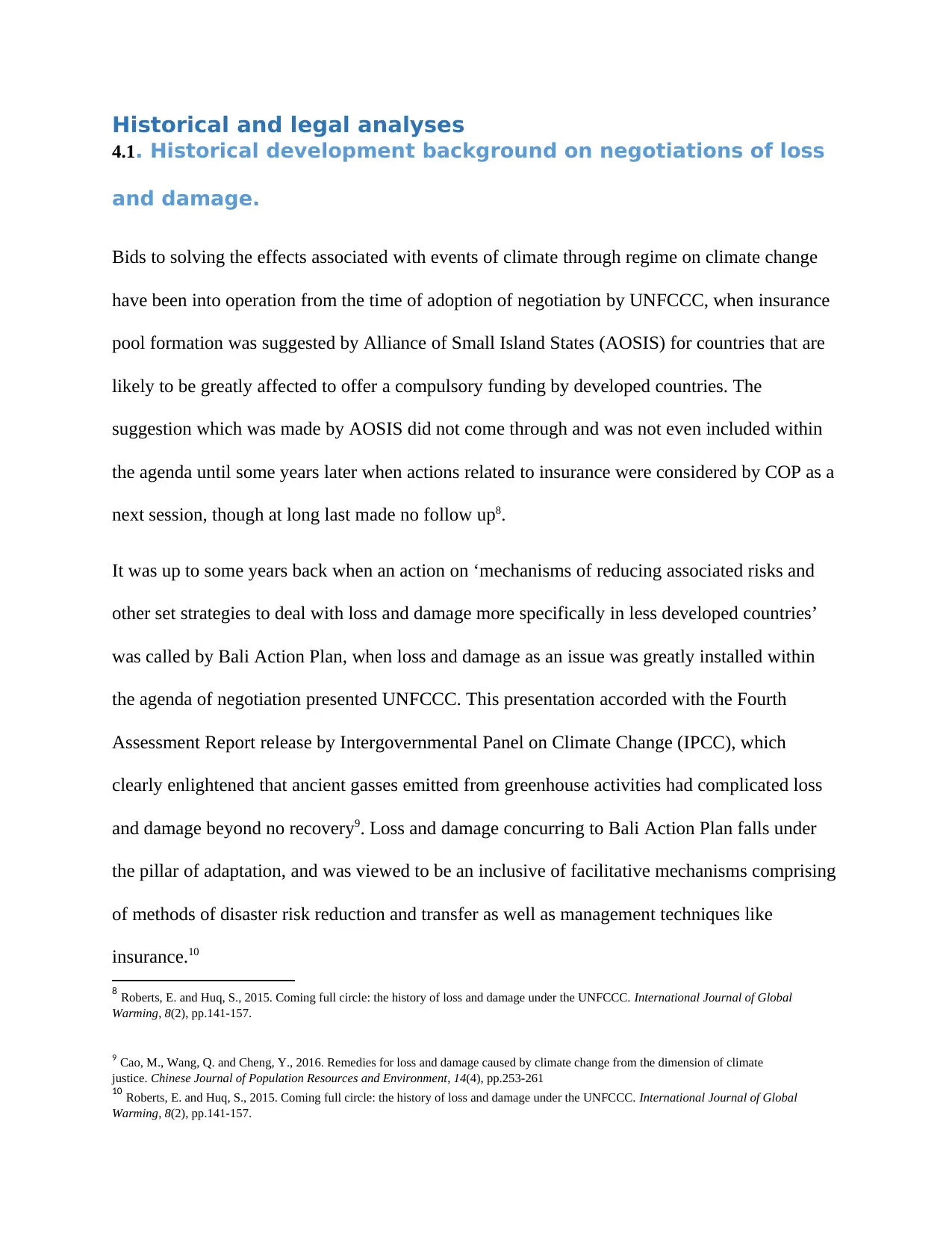
Historical and legal analyses
4.1. Historical development background on negotiations of loss
and damage.
Bids to solving the effects associated with events of climate through regime on climate change
have been into operation from the time of adoption of negotiation by UNFCCC, when insurance
pool formation was suggested by Alliance of Small Island States (AOSIS) for countries that are
likely to be greatly affected to offer a compulsory funding by developed countries. The
suggestion which was made by AOSIS did not come through and was not even included within
the agenda until some years later when actions related to insurance were considered by COP as a
next session, though at long last made no follow up8.
It was up to some years back when an action on ‘mechanisms of reducing associated risks and
other set strategies to deal with loss and damage more specifically in less developed countries’
was called by Bali Action Plan, when loss and damage as an issue was greatly installed within
the agenda of negotiation presented UNFCCC. This presentation accorded with the Fourth
Assessment Report release by Intergovernmental Panel on Climate Change (IPCC), which
clearly enlightened that ancient gasses emitted from greenhouse activities had complicated loss
and damage beyond no recovery9. Loss and damage concurring to Bali Action Plan falls under
the pillar of adaptation, and was viewed to be an inclusive of facilitative mechanisms comprising
of methods of disaster risk reduction and transfer as well as management techniques like
insurance.10
8 Roberts, E. and Huq, S., 2015. Coming full circle: the history of loss and damage under the UNFCCC. International Journal of Global
Warming, 8(2), pp.141-157.
9 Cao, M., Wang, Q. and Cheng, Y., 2016. Remedies for loss and damage caused by climate change from the dimension of climate
justice. Chinese Journal of Population Resources and Environment, 14(4), pp.253-261
10 Roberts, E. and Huq, S., 2015. Coming full circle: the history of loss and damage under the UNFCCC. International Journal of Global
Warming, 8(2), pp.141-157.
4.1. Historical development background on negotiations of loss
and damage.
Bids to solving the effects associated with events of climate through regime on climate change
have been into operation from the time of adoption of negotiation by UNFCCC, when insurance
pool formation was suggested by Alliance of Small Island States (AOSIS) for countries that are
likely to be greatly affected to offer a compulsory funding by developed countries. The
suggestion which was made by AOSIS did not come through and was not even included within
the agenda until some years later when actions related to insurance were considered by COP as a
next session, though at long last made no follow up8.
It was up to some years back when an action on ‘mechanisms of reducing associated risks and
other set strategies to deal with loss and damage more specifically in less developed countries’
was called by Bali Action Plan, when loss and damage as an issue was greatly installed within
the agenda of negotiation presented UNFCCC. This presentation accorded with the Fourth
Assessment Report release by Intergovernmental Panel on Climate Change (IPCC), which
clearly enlightened that ancient gasses emitted from greenhouse activities had complicated loss
and damage beyond no recovery9. Loss and damage concurring to Bali Action Plan falls under
the pillar of adaptation, and was viewed to be an inclusive of facilitative mechanisms comprising
of methods of disaster risk reduction and transfer as well as management techniques like
insurance.10
8 Roberts, E. and Huq, S., 2015. Coming full circle: the history of loss and damage under the UNFCCC. International Journal of Global
Warming, 8(2), pp.141-157.
9 Cao, M., Wang, Q. and Cheng, Y., 2016. Remedies for loss and damage caused by climate change from the dimension of climate
justice. Chinese Journal of Population Resources and Environment, 14(4), pp.253-261
10 Roberts, E. and Huq, S., 2015. Coming full circle: the history of loss and damage under the UNFCCC. International Journal of Global
Warming, 8(2), pp.141-157.
⊘ This is a preview!⊘
Do you want full access?
Subscribe today to unlock all pages.

Trusted by 1+ million students worldwide
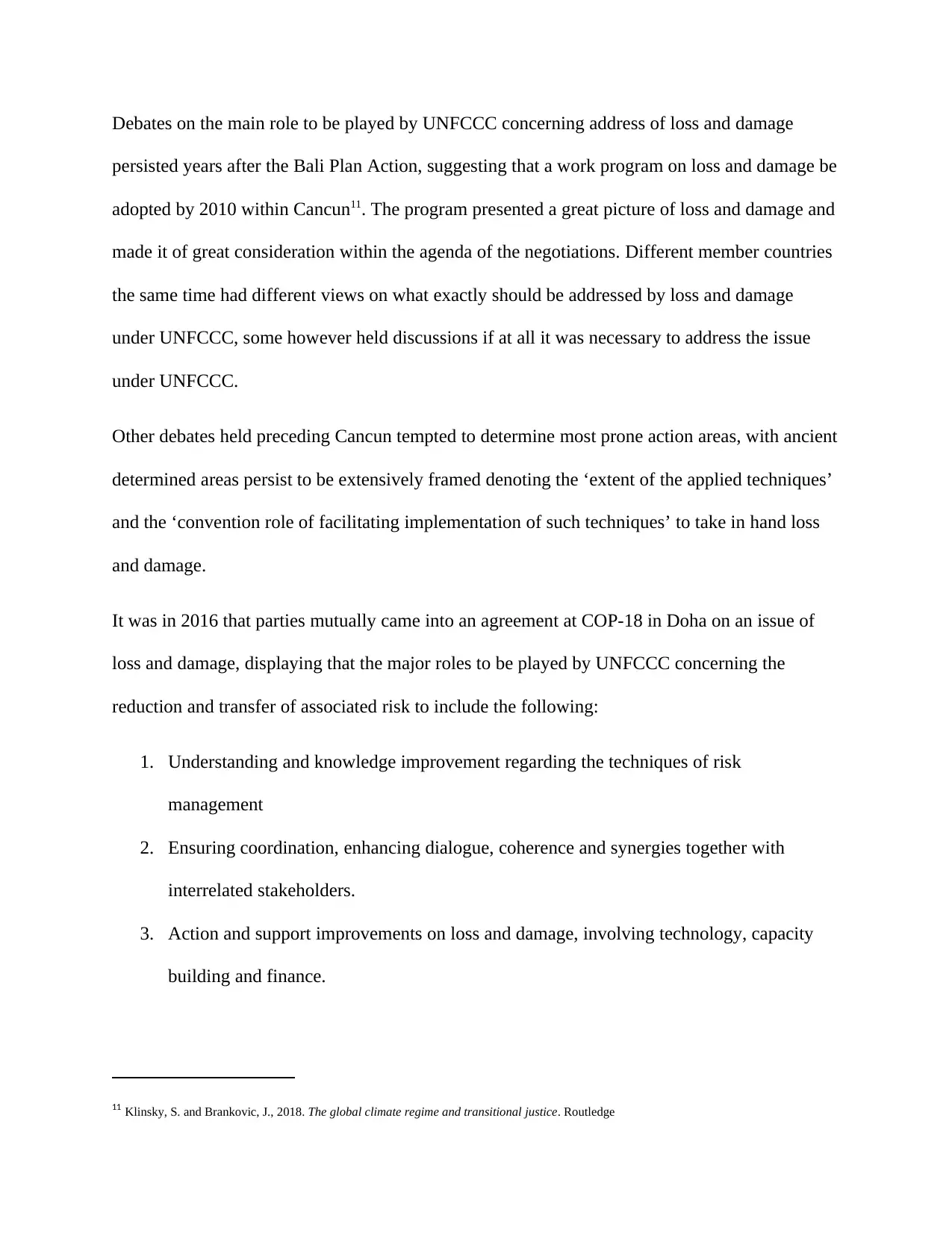
Debates on the main role to be played by UNFCCC concerning address of loss and damage
persisted years after the Bali Plan Action, suggesting that a work program on loss and damage be
adopted by 2010 within Cancun11. The program presented a great picture of loss and damage and
made it of great consideration within the agenda of the negotiations. Different member countries
the same time had different views on what exactly should be addressed by loss and damage
under UNFCCC, some however held discussions if at all it was necessary to address the issue
under UNFCCC.
Other debates held preceding Cancun tempted to determine most prone action areas, with ancient
determined areas persist to be extensively framed denoting the ‘extent of the applied techniques’
and the ‘convention role of facilitating implementation of such techniques’ to take in hand loss
and damage.
It was in 2016 that parties mutually came into an agreement at COP-18 in Doha on an issue of
loss and damage, displaying that the major roles to be played by UNFCCC concerning the
reduction and transfer of associated risk to include the following:
1. Understanding and knowledge improvement regarding the techniques of risk
management
2. Ensuring coordination, enhancing dialogue, coherence and synergies together with
interrelated stakeholders.
3. Action and support improvements on loss and damage, involving technology, capacity
building and finance.
11 Klinsky, S. and Brankovic, J., 2018. The global climate regime and transitional justice. Routledge
persisted years after the Bali Plan Action, suggesting that a work program on loss and damage be
adopted by 2010 within Cancun11. The program presented a great picture of loss and damage and
made it of great consideration within the agenda of the negotiations. Different member countries
the same time had different views on what exactly should be addressed by loss and damage
under UNFCCC, some however held discussions if at all it was necessary to address the issue
under UNFCCC.
Other debates held preceding Cancun tempted to determine most prone action areas, with ancient
determined areas persist to be extensively framed denoting the ‘extent of the applied techniques’
and the ‘convention role of facilitating implementation of such techniques’ to take in hand loss
and damage.
It was in 2016 that parties mutually came into an agreement at COP-18 in Doha on an issue of
loss and damage, displaying that the major roles to be played by UNFCCC concerning the
reduction and transfer of associated risk to include the following:
1. Understanding and knowledge improvement regarding the techniques of risk
management
2. Ensuring coordination, enhancing dialogue, coherence and synergies together with
interrelated stakeholders.
3. Action and support improvements on loss and damage, involving technology, capacity
building and finance.
11 Klinsky, S. and Brankovic, J., 2018. The global climate regime and transitional justice. Routledge
Paraphrase This Document
Need a fresh take? Get an instant paraphrase of this document with our AI Paraphraser
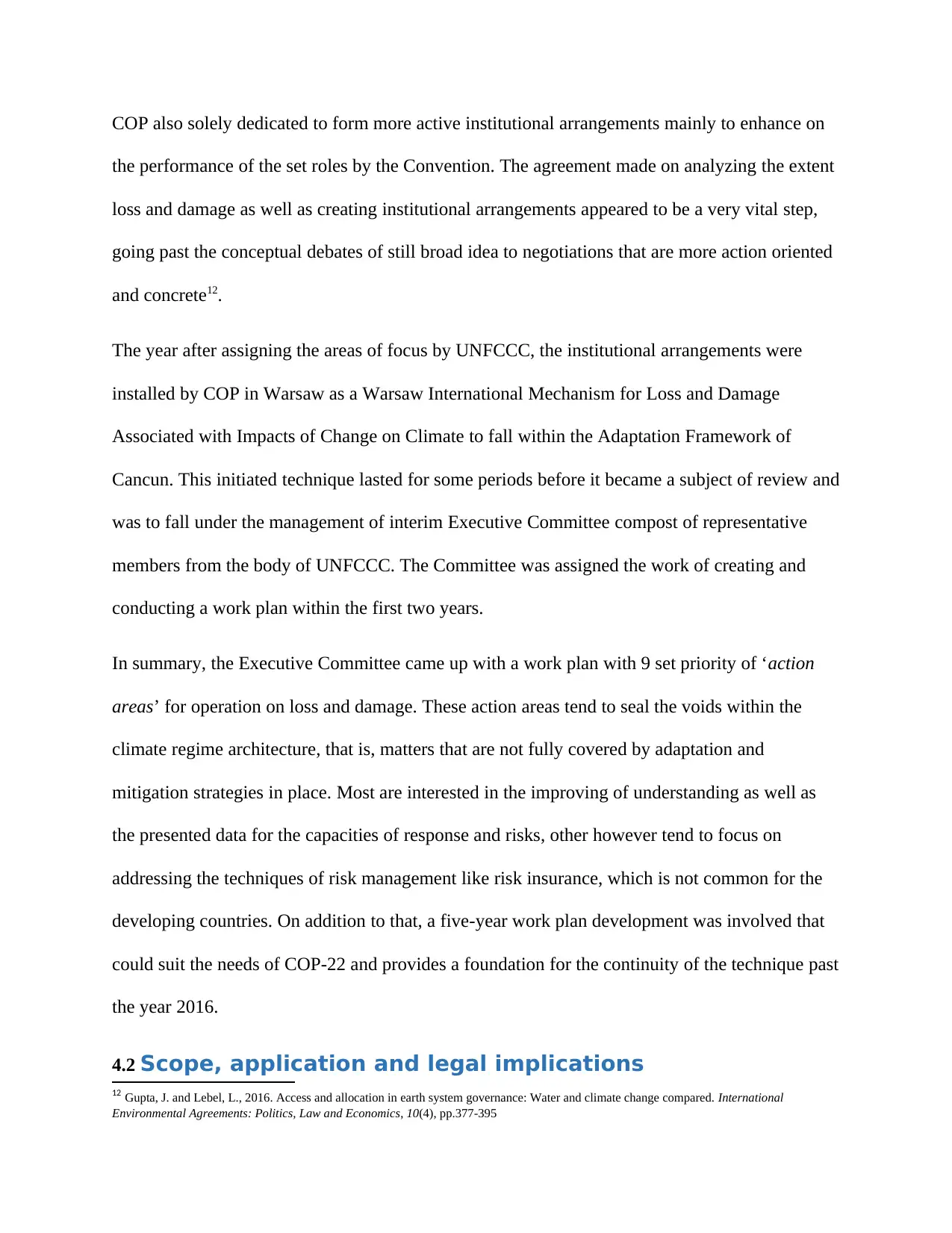
COP also solely dedicated to form more active institutional arrangements mainly to enhance on
the performance of the set roles by the Convention. The agreement made on analyzing the extent
loss and damage as well as creating institutional arrangements appeared to be a very vital step,
going past the conceptual debates of still broad idea to negotiations that are more action oriented
and concrete12.
The year after assigning the areas of focus by UNFCCC, the institutional arrangements were
installed by COP in Warsaw as a Warsaw International Mechanism for Loss and Damage
Associated with Impacts of Change on Climate to fall within the Adaptation Framework of
Cancun. This initiated technique lasted for some periods before it became a subject of review and
was to fall under the management of interim Executive Committee compost of representative
members from the body of UNFCCC. The Committee was assigned the work of creating and
conducting a work plan within the first two years.
In summary, the Executive Committee came up with a work plan with 9 set priority of ‘action
areas’ for operation on loss and damage. These action areas tend to seal the voids within the
climate regime architecture, that is, matters that are not fully covered by adaptation and
mitigation strategies in place. Most are interested in the improving of understanding as well as
the presented data for the capacities of response and risks, other however tend to focus on
addressing the techniques of risk management like risk insurance, which is not common for the
developing countries. On addition to that, a five-year work plan development was involved that
could suit the needs of COP-22 and provides a foundation for the continuity of the technique past
the year 2016.
4.2 Scope, application and legal implications
12 Gupta, J. and Lebel, L., 2016. Access and allocation in earth system governance: Water and climate change compared. International
Environmental Agreements: Politics, Law and Economics, 10(4), pp.377-395
the performance of the set roles by the Convention. The agreement made on analyzing the extent
loss and damage as well as creating institutional arrangements appeared to be a very vital step,
going past the conceptual debates of still broad idea to negotiations that are more action oriented
and concrete12.
The year after assigning the areas of focus by UNFCCC, the institutional arrangements were
installed by COP in Warsaw as a Warsaw International Mechanism for Loss and Damage
Associated with Impacts of Change on Climate to fall within the Adaptation Framework of
Cancun. This initiated technique lasted for some periods before it became a subject of review and
was to fall under the management of interim Executive Committee compost of representative
members from the body of UNFCCC. The Committee was assigned the work of creating and
conducting a work plan within the first two years.
In summary, the Executive Committee came up with a work plan with 9 set priority of ‘action
areas’ for operation on loss and damage. These action areas tend to seal the voids within the
climate regime architecture, that is, matters that are not fully covered by adaptation and
mitigation strategies in place. Most are interested in the improving of understanding as well as
the presented data for the capacities of response and risks, other however tend to focus on
addressing the techniques of risk management like risk insurance, which is not common for the
developing countries. On addition to that, a five-year work plan development was involved that
could suit the needs of COP-22 and provides a foundation for the continuity of the technique past
the year 2016.
4.2 Scope, application and legal implications
12 Gupta, J. and Lebel, L., 2016. Access and allocation in earth system governance: Water and climate change compared. International
Environmental Agreements: Politics, Law and Economics, 10(4), pp.377-395
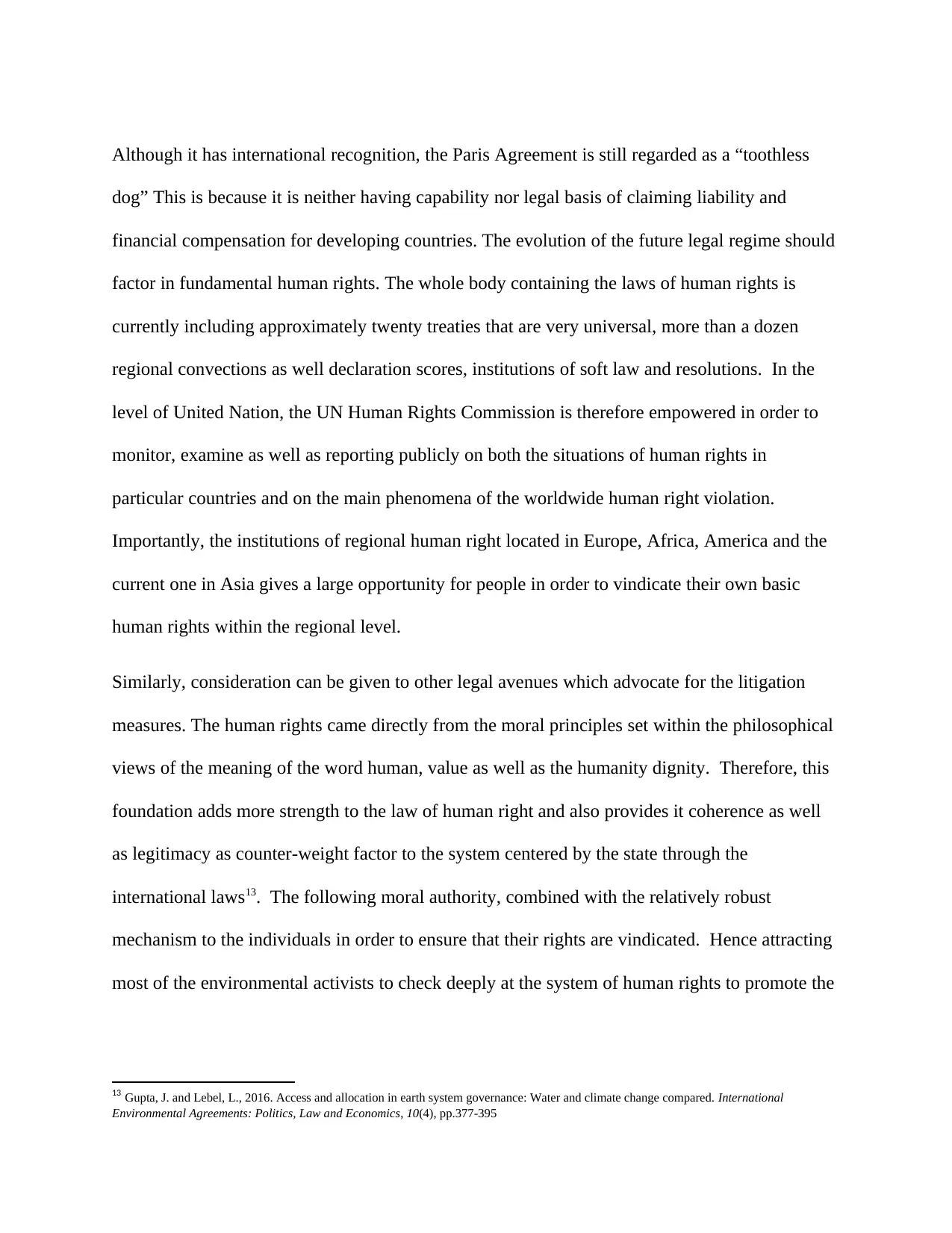
Although it has international recognition, the Paris Agreement is still regarded as a “toothless
dog” This is because it is neither having capability nor legal basis of claiming liability and
financial compensation for developing countries. The evolution of the future legal regime should
factor in fundamental human rights. The whole body containing the laws of human rights is
currently including approximately twenty treaties that are very universal, more than a dozen
regional convections as well declaration scores, institutions of soft law and resolutions. In the
level of United Nation, the UN Human Rights Commission is therefore empowered in order to
monitor, examine as well as reporting publicly on both the situations of human rights in
particular countries and on the main phenomena of the worldwide human right violation.
Importantly, the institutions of regional human right located in Europe, Africa, America and the
current one in Asia gives a large opportunity for people in order to vindicate their own basic
human rights within the regional level.
Similarly, consideration can be given to other legal avenues which advocate for the litigation
measures. The human rights came directly from the moral principles set within the philosophical
views of the meaning of the word human, value as well as the humanity dignity. Therefore, this
foundation adds more strength to the law of human right and also provides it coherence as well
as legitimacy as counter-weight factor to the system centered by the state through the
international laws13. The following moral authority, combined with the relatively robust
mechanism to the individuals in order to ensure that their rights are vindicated. Hence attracting
most of the environmental activists to check deeply at the system of human rights to promote the
13 Gupta, J. and Lebel, L., 2016. Access and allocation in earth system governance: Water and climate change compared. International
Environmental Agreements: Politics, Law and Economics, 10(4), pp.377-395
dog” This is because it is neither having capability nor legal basis of claiming liability and
financial compensation for developing countries. The evolution of the future legal regime should
factor in fundamental human rights. The whole body containing the laws of human rights is
currently including approximately twenty treaties that are very universal, more than a dozen
regional convections as well declaration scores, institutions of soft law and resolutions. In the
level of United Nation, the UN Human Rights Commission is therefore empowered in order to
monitor, examine as well as reporting publicly on both the situations of human rights in
particular countries and on the main phenomena of the worldwide human right violation.
Importantly, the institutions of regional human right located in Europe, Africa, America and the
current one in Asia gives a large opportunity for people in order to vindicate their own basic
human rights within the regional level.
Similarly, consideration can be given to other legal avenues which advocate for the litigation
measures. The human rights came directly from the moral principles set within the philosophical
views of the meaning of the word human, value as well as the humanity dignity. Therefore, this
foundation adds more strength to the law of human right and also provides it coherence as well
as legitimacy as counter-weight factor to the system centered by the state through the
international laws13. The following moral authority, combined with the relatively robust
mechanism to the individuals in order to ensure that their rights are vindicated. Hence attracting
most of the environmental activists to check deeply at the system of human rights to promote the
13 Gupta, J. and Lebel, L., 2016. Access and allocation in earth system governance: Water and climate change compared. International
Environmental Agreements: Politics, Law and Economics, 10(4), pp.377-395
⊘ This is a preview!⊘
Do you want full access?
Subscribe today to unlock all pages.

Trusted by 1+ million students worldwide
1 out of 32
Related Documents
Your All-in-One AI-Powered Toolkit for Academic Success.
+13062052269
info@desklib.com
Available 24*7 on WhatsApp / Email
![[object Object]](/_next/static/media/star-bottom.7253800d.svg)
Unlock your academic potential
Copyright © 2020–2025 A2Z Services. All Rights Reserved. Developed and managed by ZUCOL.



